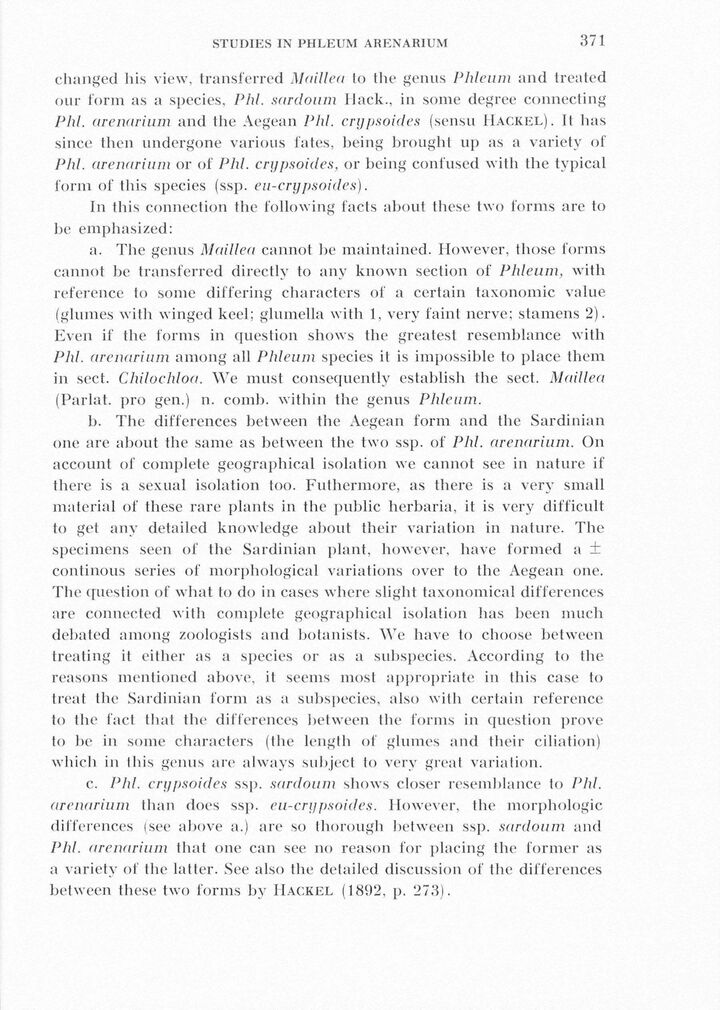
Full resolution (JPEG) - On this page / på denna sida - Sidor ...

<< prev. page << föreg. sida << >> nästa sida >> next page >>
Below is the raw OCR text
from the above scanned image.
Do you see an error? Proofread the page now!
Här nedan syns maskintolkade texten från faksimilbilden ovan.
Ser du något fel? Korrekturläs sidan nu!
This page has never been proofread. / Denna sida har aldrig korrekturlästs.
STUDIES IN PHLEUM ARENARIUM
371
changed his view. transferred Maillea to the genus Phleum and treated
our form as a species. Phl. surdoum Hack., in some degree connecting
Piil. arenarium and the Aegean Phl. crypsoides (sensu Hackel). It has
since then undergone various fätes, heing brought up as a varietv of
Phl. arenarium or of Phl. crypsoides, or being confused with the tvpical
form of this species (ssp. eii-crypsoides).
In this connection the following facts ahout these two forms are to
be emphasized:
a. The genus Maillea cannot be maintained. However, those forms
cannot be transferred directly to any known section of Phleum, with
reference lo some differing characters of a certain taxonomic value
(glumes with winged keel; glumella with 1. very faint nerve; stamens 2).
Even it’ the forms in question shows the greatest resemblance with
Phl. arenarium among all Phleum species it is impossible to place them
in sect. Chilochloa. We must consequently establish the sect. Maillea
(Parlat. pro gen.) n. comb, within the genus Phleum.
b. The differences between the Aegean form and the Sardinian
one are about the same as between the two ssp. of Phl. arenarium. Ön
account of complete geographical isolation we cannot see in nature if
there is a sexual isolation too. Futhermore, as there is a very small
material of these rare plants in the public herbaria, it is very difficult
to get any detailed knowledge about their variation in nature. The
specimens seen of the Sardinian plant, however, have forined a ±
continous series of morphological variations over to the Aegean one.
The question of what to do in cases where slight taxonomical differences
are connected with coni|)lete geographical isolation has been much
debated among zoologists and botanists. We have lo choose between
treating it either as a species or as a subspecies. According to the
reasons mentioned above, it seems most appropriate in this case to
t rea t the Sardinian form as a subspecies, also with certain reference
to the fact that the differences between the forms in question prove
to be in some characters (the length of glumes and their ciliation)
which in this genus are always subject lo verv great varialion.
c. Phl. crypsoides ssp. surdoum shows closer resemblance to /’/i/.
arenarium than does ssp. eu-crypsoides. However, the morphologic
differences (see above a.) are so thorough between ssp. surdoum and
Phl. arenarium that one can see no reason for placing the former as
a varietv of the latter. See also the detailed discussion of the differences
between these two forms by Hackel (1892, p. 273).
<< prev. page << föreg. sida << >> nästa sida >> next page >>